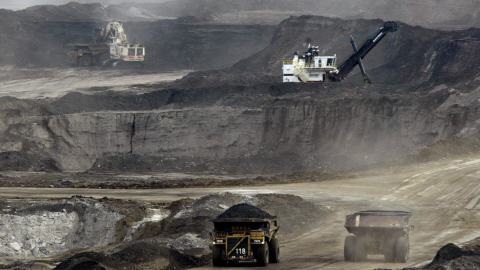So much for the slowdown in the oil sands.
Some of the world’s largest energy companies have unleashed a torrent of oil sands spending, despite industry concerns about access to export markets, soaring costs and volatile Canadian heavy crude prices.
Suncor Energy Inc., France’s Total SA and Teck Resources Ltd. gave the go-ahead to the long-delayed Fort Hills mining project, with a price tag of some $13.5-billion. Enbridge Inc. said it will spend $3-billion on pipelines for the project, where eventual output is expected to reach 180,000 barrels a day.
And Royal Dutch Shell PLC approved a steam-driven oil sands project in the Peace River, Alta., area. Shell did not provide a cost for the Carmon Creek development, slated to produce 80,000 barrels a day, though a spokesman said it would be in the billions of dollars.
The companies are proceeding with the big-ticket ventures despite industry uncertainty about approvals for export pipeline proposals such as TransCanada Corp.’s Keystone XL to the southern United States and Enbridge’s Northern Gateway to the Pacific coast.
Congested pipelines have been the main factor driving down the price of Canadian heavy crude compared with international light oil, though alternatives are being proposed, including TransCanada’s $12-billion Energy East line to New Brunswick and a host of oil-by-rail terminals.
Suncor chief executive Steve Williams insisted the company can get all its production to refineries.
“Let me be really, really clear: We have no market-access issues,” Mr. Williams said on a conference call with analysts. “We have plans in place which will take all of our base barrels and all of our growth barrels to market.” He didn’t provide details.
A year ago, Suncor delayed development of Fort Hills as part of a broader move to pull back spending along with other energy and resource companies grappling with uncertain demand and product prices. And Suncor and Total have shelved other projects, including the Voyageur upgrading plant.
Though oil sands development costs soared in recent years, Suncor said it sees an opportunity to move ahead with Fort Hills amid the industry pullback.
“One of the great benefits of Fort Hills is we actually believe we have a window of opportunity there where there’s still lots going on but it is still relatively a quiet period,” Mr. Williams said. “We’ve been able to get some very competitive contracts.”
Suncor laid out three ways it hopes it can keep the project on budget: limiting its work force to between 5,000 and 5,500 workers at a time; keeping spending constant through construction, rather than taking a big hit closer to the end; and having local, regional, and companies “further afield” build the pieces. So-called modules will be used, meaning large components will be built away from the site and all put together when they arrive.
Energy companies are taking the long view despite the industry’s several current obstacles. Fort Hills and Carmon Creek are the result of years of searching for ways to lower costs and boost efficiency as a way to withstand swings in prices for Alberta bitumen. They are due to start up in 2017, which gives the developers some breathing room on future transport capacity, said Samir Kayande, analyst at ITG investment research.
“The pipeline takeaway situation doesn’t live and die with a single producing project,” Mr. Kayande said. “We anticipate that you will need about nine million barrels a day of takeaway capacity between diluted bitumen and light oil out of Western Canada and the North Dakota Bakken by 2025.”
For Shell’s part, proceeding with Carmon Creek represents the culmination of decades of studying the resource, said Fred Wasden, manager of in-situ development. The bitumen will be produced using thermal, or steam-driven, production methods, but owing to unique geology, ones that differ from the steam-assisted gravity drainage (SAGD) projects around Fort McMurray.
“We’re using a vertical steam-drive process, and as a result we’re going to develop the field with quite a few more wells than you would see in a SAGD process,” Mr. Wasden said. “You’ll also see that our recovery efficiency is actually higher.”
The company declined to provide the costs per barrel, though Mr. Wasden said returns are expected to be “competitive with Shell’s global portfolio of projects.”
The idea is to integrate the project with some of Shell’s other businesses, including the Duvernay shale gas liquids operations in Alberta, from which it can get diluent, and its refineries around the continent, which can process the oil. Without giving details, Mr. Wasden said Shell has entered into agreements with pipeline companies that ensure the output will get to market. “We won’t be stranded, and we won’t be relying on train cars to get our bitumen out of the area,” he said.
Big boost for oil sands as key players forge ahead
Carrie Tait, Jeffrey Jones


























Laissez un commentaire Votre adresse courriel ne sera pas publiée.
Veuillez vous connecter afin de laisser un commentaire.
Aucun commentaire trouvé